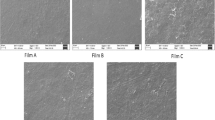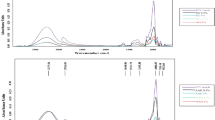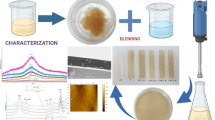Abstract
For the last decades, the food industry has been searching for cleaner alternatives to petroleum-derived plastics to ensure food safety, such as edible films. Although tapioca starch and proteins have good film-forming abilities separately, the combination of both may enhance their properties. This study aims to investigate the effect of the combination of three concentrations (80:20 w/w, 70:30 w/w, and 60:40 w/w) of tapioca starch and protein (porcine gelatine or whey protein concentrate) and three concentrations of glycerol (2% w/w, 2.5% w/w, and 3% w/w) on the mechanical and thermo-sealing properties of edible films. Tensile strength, deformation at break, firmness, Young’s modulus, heat-sealing capacity, and the necessary energy to cause an adhesive failure were studied. Results showed that the different combinations of starch, glycerol, and proteins allow the formation of materials with a wide range of characteristics. All the tested films showed potential to be used as food containers, those obtained from tapioca starch and gelatin were stronger, firmer, and less deformable than tapioca starch: whey protein films. More studies should be carried out in order to determine their application, such as water affinity, compatibility with food matrices or other substances, and microbiological stability.




Similar content being viewed by others

Data Availability
All data generated or analyzed during this study are included in this published article.
References
Abedinia, A., Ariffin, F., Huda, N., & Mohammadi Nafchi, A. (2018). Preparation and characterization of a novel biocomposite based on duck feet gelatin as alternative to bovine gelatin. International Journal of Biological Macromolecules, 109, 855–862. https://doi.org/10.1016/j.ijbiomac.2017.11.051
American Society for Testing and Materials – ASTM. (2001). Standard test method for seal strength of flexible barrier materials – ASTM F88–00. ASTM Standards on Disc (vol. 15.09, p. 6). Philadelphia: ASTM.
Basiak, E., Galus, S., & Lenart, A. (2015). Characterisation of composite edible films based on wheat starch and whey-protein isolate. International Journal of Food Science and Technology, 50(2), 372–380. https://doi.org/10.1111/ijfs.12628
Basiak, E., Lenart, A., & Debeaufort, F. (2018). How glycerol and water contents affect the structural and functional properties of starch-based edible films. Polymers, 10(4), 412. https://doi.org/10.3390/POLYM10040412
Ben, Z. Y., & Samsudin, H.,; Yhaya, M. F. (2022). Glycerol: Its properties, polymer synthesis, and applications in starch based films. European Polymer Journal, 175, 111377. https://doi.org/10.1016/J.EURPOLYMJ.2022.111377
Chang, Y. P., Abd Karim, A., & Seow, C. C. (2006). Interactive plasticizing–antiplasticizing effects of water and glycerol on the tensile properties of tapioca starch films. Food Hydrocolloids, 20(1), 1–8. https://doi.org/10.1016/J.FOODHYD.2005.02.004
Chollakup, R., Pongburoos, S., Boonsong, W., Khanoonkon, N., Kongsin, K., Sothornvit, R., Sukyai, P., Sukatta, U., & Harnkarnsujarit, N. (2020). Antioxidant and antibacterial activities of cassava starch and whey protein blend films containing rambutan peel extract and cinnamon oil for active packaging. LWT, 130, 109573. https://doi.org/10.1016/J.LWT.2020.109573
Cortés-Rodríguez, M., Villegas-Yépez, C., Gil González, J. H., Rodríguez, P. E., & Ortega-Toro, R. (2020). Development and evaluation of edible films based on cassava starch, whey protein, and bees wax. Heliyon, 6(9), e04884. https://doi.org/10.1016/j.heliyon.2020.e04884
Dhumal, C. V., & Sarkar, P. (2018). Composite edible films and coatings from food-grade biopolymers. Journal of Food Science and Technology, 55(11), 4369–4383. https://doi.org/10.1007/S13197-018-3402-9
Díaz-Montes, E., & Castro-Muñoz, R. (2021). Edible films and coatings as food-quality preservers: an overview. Foods, 10(2), 249. https://doi.org/10.3390/foods10020249
Galus, S., & Kadzińska, J. (2016). Moisture sensitivity, optical, mechanical and structural properties of whey protein-based edible films incorporated with rapeseed oil. Food Technology and Biotechnology, 54(1), 78. https://doi.org/10.17113/FTB.54.01.16.3889
Galus, S., Kibar, E. A. A., Gniewosz, M., & Kraśniewska, K. (2020). Novel materials in the preparation of edible films and coatings—a review. Coatings, 10(7), 674. https://doi.org/10.3390/COATINGS10070674
GraphPad Prism version 8.0.0 for Windows. GraphPad Software, San Diego, California USA. Retrieved November 27, 2018, from www.graphpad.com
Hammam, A. R. A. (2019). Technological, applications, and characteristics of edible films and coatings: A review. SN Applied Sciences, 1(6), 1–11. https://doi.org/10.1007/S42452-019-0660-8/FIGURES/2
Hassan, B., Chatha, S. A. S., Hussain, A. I., Zia, K. M., & Akhtar, N. (2018). Recent advances on polysaccharides, lipids and protein based edible films and coatings: a review. International Journal of Biological Macromolecules, 109, 1095–1107. https://doi.org/10.1016/j.ijbiomac.2017.11.097. Elsevier B.V.
InfoStat. (2018). InfoStat versión 2008. FCA, Universidad Nacional de Córdoba, Argentina.
Kandasamy, S., Yoo, J., Yun, J., Kang, H.-B., Seol, K.-H., Kim, H.-W., & Ham, J.-S. (2021). Application of whey protein-based edible films and coatings in food industries: an updated overview. Coatings, 11(9), 1056. https://doi.org/10.3390/coatings11091056
Kocira, A., Kozłowicz, K., Panasiewicz, K., Staniak, M., Szpunar-Krok, E., & Hortyńska, P. (2021). Polysaccharides as edible films and coatings: characteristics and influence on fruit and vegetable quality–a review. Agronomy, 11(5), 813. https://doi.org/10.3390/agronomy11050813
Liu, C., Huang, J., Zheng, X., Liu, S., Lu, K., Tang, K., & Liu, J. (2020). Heat sealable soluble soybean polysaccharide/gelatin blend edible films for food packaging applications. Food Packaging and Shelf Life, 24, 100485. https://doi.org/10.1016/J.FPSL.2020.100485
López, O. V., Lecot, C. J., Zaritzky, N. E., & García, M. A. (2011). Biodegradable packages development from starch based heat sealable films. Journal of Food Engineering, 105(2), 254–263. https://doi.org/10.1016/J.JFOODENG.2011.02.029
Mali, S., Grossmann, M. V. E., Garcia, M. A., Martino, M. N., & Zaritzky, N. E. (2008). Antiplasticizing effect of glycerol and sorbitol on the properties of cassava starch films. Brazilian Journal Of Food Technology, 11(3), 194–200. https://doi.org/10.5433/1679-0359.2007v28n1p79
Murrieta-Martínez, C. L., Soto-Valdez, H., Pacheco-Aguilar, R., Torres-Arreola, W., Rodríguez-Felix, F., & Márquez Ríos, E. (2018). Edible protein films: Sources and behavior. Packaging Technology and Science, 31(3), 113–122. https://doi.org/10.1002/pts.2360
Ollé Resa, C. P., Gerschenson, L. N., & Jagus, R. J. (2014). Natamycin and nisin supported on starch edible films for controlling mixed culture growth on model systems and Port Salut cheese. Food Control, 44, 146–151. https://doi.org/10.1016/J.FOODCONT.2014.03.054
Otoni, C. G., Avena-Bustillos, R. J., Azeredo, H. M. C., Lorevice, M. V., Moura, M. R., Mattoso, L. H. C., & McHugh, T. H. (2017). Recent advances on edible films based on fruits and vegetables–a review. Comprehensive Reviews in Food Science and Food Safety, 16(5), 1151–1169. https://doi.org/10.1111/1541-4337.12281
Pellá, M. C. G., Silva, O. A., Pellá, M. G., Beneton, A. G., Caetano, J., Simões, M. R., & Dragunski, D. C. (2020). Effect of gelatin and casein additions on starch edible biodegradable films for fruit surface coating. Food Chemistry, 309, 125764. https://doi.org/10.1016/j.foodchem.2019.125764
Pérez, P. F., Ollé Resa, C. P., Gerschenson, L. N., et al. (2021). Addition of zein for the improvement of physicochemical properties of antimicrobial tapioca starch edible film. Food Bioprocess Technology, 14, 262–271. https://doi.org/10.1007/s11947-020-02565-z
Ploypetchara, T., & Gohtani, S. (2018). Effect of sugar on starch edible film properties: Plasticized effect. Journal of Food Science and Technology, 55(9), 3757–3766. https://doi.org/10.1007/s13197-018-3307-7
Ra’il, N. H., Saputro, A. G., Ataollahi, N., Ahmad, A., & Mobarak, N. N. (2022). The role of disaccharides as a plasticizer in improving the interaction between chitosan chain based solid polymer electrolytes (SPEs). New Journal of Chemistry, 46(8), 3844–3855. https://doi.org/10.1039/d1nj05735a
Ribeiro, A. M., Estevinho, B. N., & Rocha, F. (2021). Preparation and incorporation of functional ingredients in edible films and coatings. Food Bioprocess Technology, 14, 209–231. https://doi.org/10.1007/s11947-020-02528-4
Saberi, B., Vuong, Q., Chockchaisawasdee, S., Golding, J., Scarlett, C., & Stathopoulos, C. (2016). Mechanical and physical properties of pea starch edible films in the presence of glycerol: properties of pea starch edible films. Journal of Food Processing and Preservation, 40, 1339–1351. https://doi.org/10.1111/jfpp.12719
Said, N., Nazlin, A., Howell, K., & Sarbon, N. M. (2021). A review on potential use of gelatin-based film as active and smart biodegradable films for food packaging application. Food Reviews International. https://doi.org/10.1080/87559129.2021.1929298
Siracusa, V., Rocculi, P., Romani, S., & Rosa, M. D. (2008). Biodegradable polymers for food packaging: a review. Trends in Food Science and Technology, 19(12), 634–643. https://doi.org/10.1016/j.tifs.2008.07.003
Soliman, E. A., & Furuta, M. (2014). Influence of phase behavior and miscibility on mechanical, thermal and micro-structure of soluble starch-gelatin thermoplastic biodegradable blend films. Food and Nutrition Sciences, 05(11), 1040–1055. https://doi.org/10.4236/FNS.2014.511115
Suderman, N., Isa, M. I. N., & Sarbon, N. M. (2018). Characterization on the mechanical and physical properties of chicken skin gelatin films in comparison to mammalian gelatin films. IOP Conference Series: Materials Science and Engineering, 440(1), 012033. https://doi.org/10.1088/1757-899X/440/1/012033
Suh, J. H., Ock, S. Y., Park, G. D., Lee, M. H., & Park, H. J. (2020). Effect of moisture content on the heat-sealing property of starch films from different botanical sources. Polymer Testing, 89, 106612. https://doi.org/10.1016/J.POLYMERTESTING.2020.106612
Tian, K., & Bilal, M. (2019). Research progress of biodegradable materials in reducing environmental pollution. Abatement of environmental pollutants: trends and strategies (pp. 313–330). Elsevier. https://doi.org/10.1016/B978-0-12-818095-2.00015-1
Tongdeesoontorn, W., Mauer, L. J., Wongruong, S., Sriburi, P., & Rachtanapun, P. (2012). Mechanical and physical properties of cassava starch-gelatin composite films. International Journal of Polymeric Materials and Polymeric Biomaterials, 61(10), 778–792. https://doi.org/10.1080/00914037.2011.610049
Ulyarti, U., Nazarudin, N., Surhaini, Lisani, Ramadon, R., & Lumbanraja, P. (2020). Cassava starch edible film with addition of gelatin or modified cassava starch. IOP Conference Series: Earth and Environmental Science, 515(1), 012030. https://doi.org/10.1088/1755-1315/515/1/012030
van der Sman, R. G. M. (2019). Phase separation, antiplasticization and moisture sorption in ternary systems containing polysaccharides and polyols. Food Hydrocolloids, 87, 360–370. https://doi.org/10.1016/J.FOODHYD.2018.07.051
Wang, K., Wang, W., Ye, R., Xiao, J., Liu, Y., Ding, J., Zhang, S., & Liu, A. (2017). Mechanical and barrier properties of maize starch-gelatin composite films: effects of amylose content. Journal of the Science of Food and Agriculture, 97(11), 3613–3622. https://doi.org/10.1002/JSFA.8220
Wang, S., & Zhu, F. (2015). Formulation and quality attributes of quinoa food products. Food and Bioprocess Technology, 9, 49–68. https://doi.org/10.1007/s11947-015-1584-y
Zhao, X., Cornish, K., & Vodovotz, Y. (2020). Narrowing the gap for bioplastic use in food packaging: an update. Environmental Science & Technology, 54(8), 4712–4732. https://doi.org/10.1021/ACS.EST.9B03755
Acknowledgements
The authors also thank Arla Foods S.A. (Argentina).
Funding
This study was financially supported by the University of Buenos Aires (UBACyT 20020170100229BA, 2018–2021 and 20020170100063BA, 2018–2021) and by the National Agency of Scientific and Technical Research (PICT2019-01551, 2021–2024 and MINCyT. PICT-2017- 1146. 2019–2022).
Author information
Authors and Affiliations
Contributions
Yanina Izzi: investigation, statistical analysis of data, writing, and writing–review and editing; Lía Gerschenson: experimental design, resources, and writing–review and editing; Rosa Jagus: experimental design, resources, and writing–review and editing; Carolina Ollé: experimental design, supervision, and writing–review and editing.
Corresponding author
Ethics declarations
Conflict of Interest
The authors declare no competing interests.
Additional information
Publisher's Note
Springer Nature remains neutral with regard to jurisdictional claims in published maps and institutional affiliations.
Rights and permissions
Springer Nature or its licensor (e.g. a society or other partner) holds exclusive rights to this article under a publishing agreement with the author(s) or other rightsholder(s); author self-archiving of the accepted manuscript version of this article is solely governed by the terms of such publishing agreement and applicable law.
About this article
Cite this article
Izzi, Y.S., Gerschenson, L.N., Jagus, R.J. et al. Edible Films Based on Tapioca Starch and WPC or Gelatine Plasticized with Glycerol: Potential Food Applications Based on Their Mechanical and Heat-Sealing Properties. Food Bioprocess Technol 16, 2559–2569 (2023). https://doi.org/10.1007/s11947-023-03089-y
Received:
Accepted:
Published:
Issue Date:
DOI: https://doi.org/10.1007/s11947-023-03089-y



